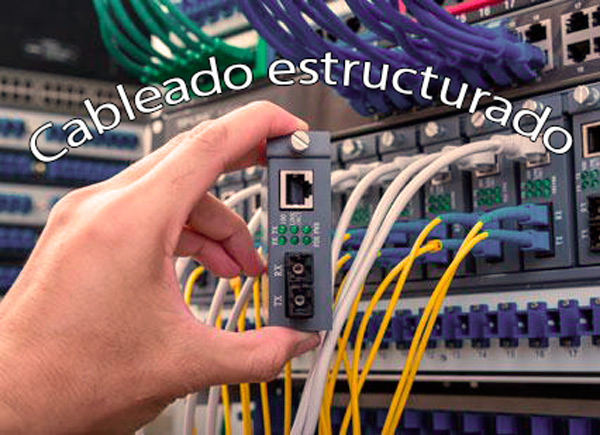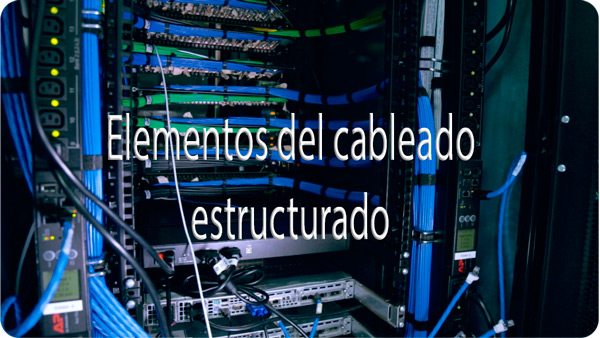
Structured cabling is usually that of cables that are inside a enclosure or building and that it is installed with the aim of implementing a area network local . Which is made up of a system of connectors, cables, pipes and devices .
These cables are intended to be able to send different signals capable of establishing a network connection. In addition, the installation of this wiring must meet some requirements , have Please note that these depend on the place of residence.
With all this in mind, here we will explain a little more about what is this type of wiring and what is its main function , among other important factors. To do this, carefully follow each of the details that we will explain below:
Index:
What is a wiring structure and what is it for in computing?

The wiring structure is a cable run that is located in inside a building in order to implement a network connection, where its structure contains a combination of protected or unprotected twisted pair cables, in these cases it is the SST and UTP . Sometimes they also contain coaxial and fiber optic cables, all these cables are capable of integrating data, video and voice services .
In general, the use of this type of system allows to establish and create telecommunications infrastructures inside an enclosure or building , thus offering easy installation. Among one of its main advantages we find that it is standardized, which gives it an advantage over the suppliers and growth in a simpler way.
This allows this system to be installed without first knowing the product to use, since it is unified to the computer and communications systems of any company . It can be used to establish clean area or local area networks.
According to this, the vast majority of current buildings have to go through create a wiring structure inside, what will become part of your system network and communication. These systems that are added to the infrastructure have to be created in order to cover all the needs during a period of time of 20 to At least 25 years .
What are the most important elements of a structured cabling system ?

This system has some elements that are fundamental for its development, in this case it is the horizontal, vertical cabling and the telecommunications room. Next, we explain a little more about each one of them.
Horizontal wiring
In this case, he is responsible for carrying or transmitting the information from the floor distributor to the network users . It works under the EIA / TIA 568A standard, where it is also known as “The portion of the wired telecommunications system that extends from the work area to the main telecommunications room.”
It is usually made up of a core solid that is made of copper , this in order to prevent that twist or suffer damage . In addition, it is recommended that it be placed behind the walls preventing the public from having contact with him.
This type of horizontal cabling includes the following elements:
- Horizontal cables .
- Mechanical termination .
- Horizontal interconnections that they must be located within the telecommunications room .
- Outlets .
- Connectors in the work area.
- Transition cables and connectors installed between the output of the work area and the main room.
- Panels and cables splice that are used to configure the cable connections in the main room.
Vertical wiring
It is also currently known as trunk or backbone wiring , and its main function is to create interconnections between different equipment rooms, telecommunication rooms and service entrance rooms >. It is usually made up of vertical cables, main and intermediate cross connections, patch cords for cross connections or mechanical terminations.
This vertical system is responsible for carrying out what is the interconnection between the different telecommunications cabinets and the equipment room . However, this time this vertical system is not as accessible or economical as is the structure used in the horizontal cabling system . But, it allows you to perform installations independently for data and telephone.
By allowing standalone installation it allows that when you want to replace the backbone this does not require a high cost of service. Therefore, its modification turns out to be easier and cheaper for the inhabitants of the building.
The backbone includes the following elements:
- Backbone pipes can be both vertical and horizontal between the different floors of the building.
- Includes a means of cable transmission .
- It has main and intermediate points of crossed connections and mechanical terminations.
Telecommunication room
This room is created and destined only for what is the accommodation of all the elements that make up the telecommunication system . In other words, the switches must be found in it, as well as all the centralized elements that circulate through the horizontal sections to the workplace .
This space must have specific characteristics on which its operation depends, as well as its duration. Therefore, here we show you what are the main features to take into account when establishing this room:
- It must have a minimum height of 2.6 meters , this being the most recommended.
- The ambient temperature must be between 18 and 24 ° C , especially if active equipment is owned there.
- It must have humidity between 30% and 50%, in the case If this is not met, it must have an internal humidity of 85%, but a temperature between 10 and 35 ° C.
- Your location must not mean any kind of risk , that is, you are not in a space that can be flooded in the event of a natural event , or that you can have any contact with the water inside . In addition, it is recommended to perform drainage channels in your floor .
- You must have a minimum of two outlets inside , one of them 110 V and another of 15 A, each must have a completely different circuit.
- These rooms must be only to be treated telecommunications systems, en say that there should be no facilities that are not related to this.
Rules for the creation of structured cabling How should it be done in Spain ?

When guarantee an infrastructure or the development of a project on a wiring system , it is important that it be based under a series of standards that are established by a legal body involved in the development of these systems.
Compliance with each of these standards and considerations will make the operation and installation performance correct and ensure its optimal development. In addition, this will help to reduce the risks that may be detrimental to its operation.
With this in mind, then we explain what these rules should be taken into account when creating one of these systems:
ANSI / TIA / EIA-568 -B
Telecommunications wiring in commercial buildings, TIA / EIA 568-B1 general requirements, TIA / EIA 568-B2 wiring components mediating a twisted pair, TIA / EIA 568-B3 fiber optic cabling component.
ANSI / TIA / EIA-569 -A
Route rules and telecommunication space in commercial buildings on how to route the cable.
ANSI / TIA / EIA-570 -A
Standards for light residential and commercial infrastructure of telecommunications.
ANSI / TIA / EIA-606 -A
Standard of the Infrastructure management in commercial buildings.
ANSI / TIA / EIA-607
Requirement for the installation of telecommunications grounding system in commercial buildings.
ANSI / TIA / EIA-758
Client-Owner standard for external plant wiring.
What is needed to create a cable system for a network LAN?
It is possible that you are interested in being able to create a cable system for what is a LAN , in this case you can do it as long as you have a knowledge about what this is system and how it works .
Once you have this clear you can perform the steps that we will teach you below:
Collect information

In this first process you have to gather all the necessary information that you are going to use to be able to work with the network. Therefore, if it is a residential building you must take into account a database on the inhabitants, apartments and other factors involved.
Planning

Once you have defined the previous point, the following will be to prepare a planning that will help you the decision making . In this case you must elaborate previous tests on structured cabling , where the steps of location, design and quotation are found of all implementations and resources to use.
It is important that when purchasing the necessary equipment, a standard or model is established in order to avoid structural and functional accidents .
Negotiation

Keep in mind that when conducting legal business some parameters must be established which help avoid problems in the future . Keep in mind that these parameters are directly related to the scale in which the network is located, since if it is a small network it does not require many procedures. But, in the case of a more advanced network requires technical certifications to ensure its effectiveness .
Installation

Once all the previous steps have been completed, proceed with the installation , as this will allow this process to be much more secure and reliable.
Quality verification

Once you have finished executing the structured cabling , it is important to verify its operation. This will help to know if there is any problem structural and functional . Once all this has been verified, these problems should not affect the structural wiring during operation.
The documentation
Once all the above is done and finally, it is important to make a detailed report of the state in which the system is , this to have a basis of the current operation with regarding the possible failures that may occur in the future.
The most advisable thing is to enumerate each one of the possible failures so that later only review the document and solve them . It is important to ensure that the system is safe and reliable in order to ensure its quality.